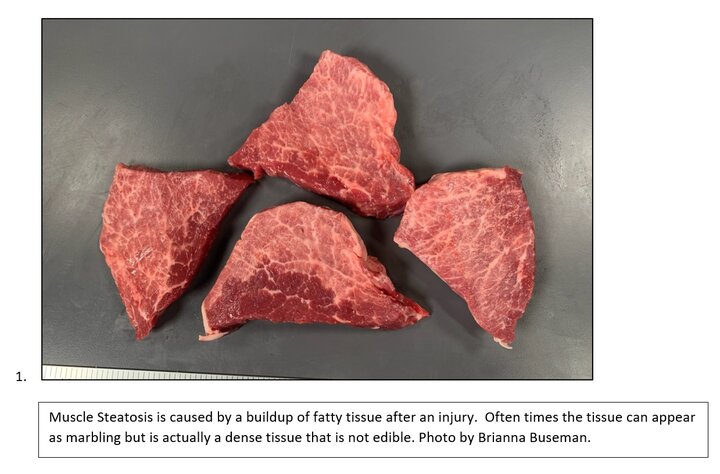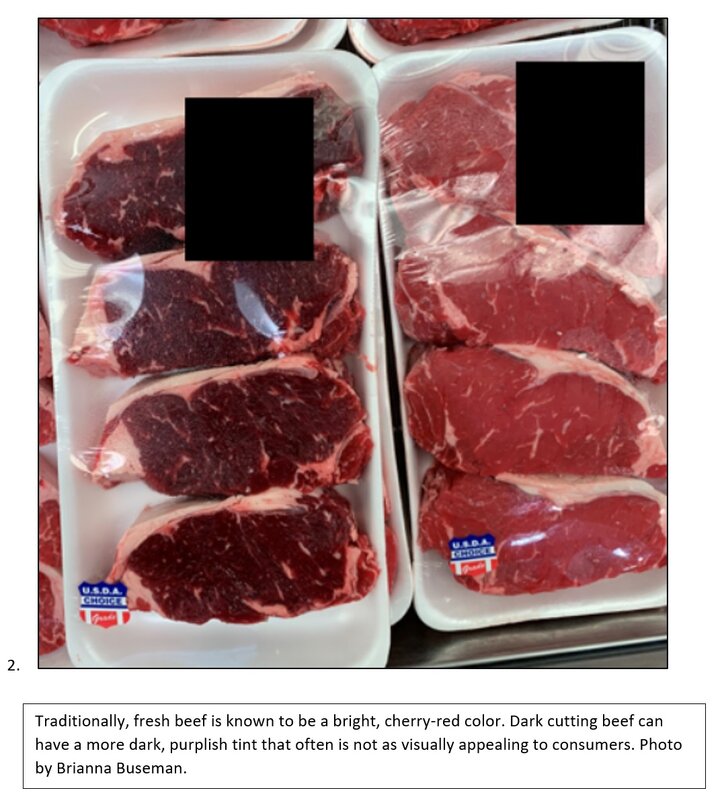Quality is a prediction of the expected palatability of a carcass. Quality grade is based off animal maturity and marbling. In addition to these factors, other characteristics such as color, texture and firmness of the final product are considered by those making purchasing decisions. Differences in these characteristics can be impacted by several different things and often tie back to the life of the animal. It is often noted that the combination of genetics and environment can impact the phenotype, or physical characteristics, of an animal. Additionally, factors at play during the harvest process can impact the final product. The characteristics that are used to determine quality and yield grade are a form of phenotype and can be impacted by a variety of factors.
Genetics:
Breed: Traditionally, British breeds, such as Angus cattle, are more known for producing higher quality carcasses with higher marbling potential. Continental breeds, such Piedmontese and Simmental, are more known for growth and muscling.
Genetic selection: Utilizing genetic selection can allow for cattle to be raised based on carcass factors such as marbling ability and ribeye area. Even under ideal environmental conditions, cattle will only be able to grade to the best of their genetic ability.
Environment:
Feed/Nutrition: Variation in diet can create variability in carcasses. If an animal is not fed the right diet, they will not be able to reach their genetic potential to grade well. Feeding high energy diets (grain based) allows for energy storage in the form of marbling deposition. Low energy diets (forage based), may not allow for marbling deposition and can lead slower growing, older animals at harvest that results in a lower quality graded product. Additionally, high levels of beta-carotene found in many grasses can cause the fat of grass-fed beef to have a yellow tint. This is not a safety concern; however, it may not be as visually appealing to some consumers. There can also be a taste difference between products that come from grass fed beef versus grain fed beef.
Weather: The Midwest is known for its variety of weather as well as for the weather making extreme changes in a short amount of time. The swings in weather can create a high level of stress on the animal that can have an impact on the final product (more about stress below).
Handling/Working Facilities: Poor animal handling as well as inefficient working facilities can not only lead to stress on the animal, but can also cause injury. Due to the hide, we don’t see bruises on cattle; however, bruising can be a big problem when it comes to the carcasses. Bruises need to be cut out and the cuts that are impacted by the broken capillaries within the bruise are not able to be used. This can devalue portions of or the entire carcass. Additionally, injuries that heal can lead to muscular steatosis which is a fatty buildup of tissue within the muscle (similar to scar tissue) that is not edible1. Finally, injection site lesions can lead to fluid filled pockets within the muscle that can make its way into the final product.
Stress: All of these factors can lead to stress on the animal. When an animal is harvested, there is a natural process that occurs as muscle converts to meat. One of the changes that occurs is a decline in pH, or a change in the acidity. Living muscle tissue has a pH of nearly neutral, or about 7.0. As muscle converts to meat, it becomes slightly acidic as the pH drops to about 5.4-5.8. The rate at which this happens as well as the final pH that the product reaches can have big impacts on quality. In beef animals, long term stress can lead to a depletion of the energy source within the muscle which leads to a poor pH decline. When the animal is harvested, the pH doesn’t decline like it is supposed to and leads to a product that is a dark purplish-red color, has a dry tacky surface, and retains moisture, known as a dark cutter2. Though still safe to consume, the product loses its visual appeal, has a shorter shelf life due to the more neutral pH and higher moisture content, and can be tough when consumed. Often times, dark cutting carcasses will not be graded at the packing plant and may be used in some further processed products.
In addition to creating a dark product, stress during life can cause livestock to go off feed. This may result in less energy needed for growth as well as a lower level of marbling. Keeping the stress level low is very important to producing a high-quality product!
Harvest:
There are several steps within the harvest process that need to be carefully controlled to support the product quality. If exsanguination (bleeding out) is not done quickly and effectively, it can lead to capillaries within the muscle to rupture and create blood splash. Blood splash can lead to safety concern as blood is a good habitat for bacteria growth, can be unappealing and poor tasting. Additionally, factors at the processing facility such as temperature, airflow, sanitation, aging ability, hang time, packaging and more can all impact the final eating experience.
The process of getting a high-quality product to the table is extensive. From before the animal is born to the time it reaches the plate, the eating experience can be impacted. A combination of the genetic ability of the animal and the environment it is raised in lays a foundation for the value of that carcass. The way that it is harvested and eventually how the product is prepared can build upon this foundation to create a great tasting product.


Interviews with the authors of BeefWatch newsletter articles become available throughout the month of publication and are accessible at https://go.unl.edu/podcast.
Topics covered:
Beef Quality Assurance & cattle welfare, Feedlot, Backgrounding & feedlot

